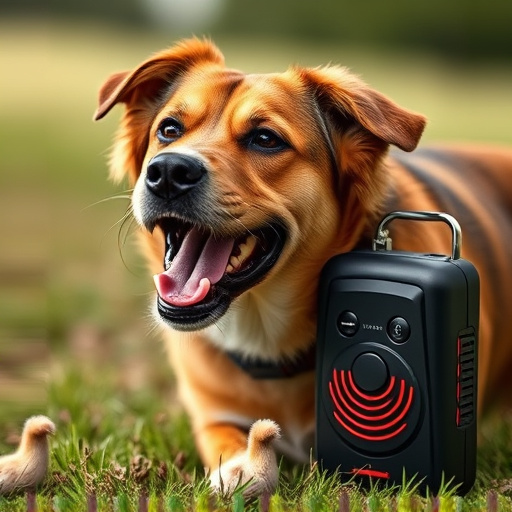Understanding and addressing aggressive dog behavior, especially excessive barking, is vital for responsible pet ownership. Ultrasonic dog deterrents offer a humane solution by using inaudible high-frequency sound waves to capture a dog's attention when it barks or displays aggression. Customizing bark control intensity settings is key; lower intensities prevent barking, while higher settings gently stimulate persistent barking. Regular adjustments and training with alternative behaviors ensure positive results without causing discomfort, enhancing the deterrent's effectiveness over time.
Many pet owners face challenges with aggressive dog behavior, which can impact their quality of life. An effective solution gaining popularity is the ultrasonic dog deterrent, a non-violent training tool that uses sound to curb unwanted barking. This article explores aggressive dog behavior and introduces ultrasonic deterrents as a humane alternative. We’ll guide you through setting up and customizing bark control intensity settings for optimal results, along with implementation tips to ensure successful training.
- Understanding Aggressive Dog Behavior and Its Impact
- Introduction to Ultrasonic Dog Deterrents: How They Work
- Customizing Bark Control Intensity Settings for Optimal Effectiveness
- Implementation and Training Tips for Successful Use of Ultrasonic Dog Deterrents
Understanding Aggressive Dog Behavior and Its Impact
Understanding aggressive dog behavior is a crucial step in effectively managing and addressing it. Dogs may display aggression for various reasons, including fear, territorial instincts, or past traumatic experiences. This behavior can range from mild growling to more severe biting incidents, impacting their relationships with owners and others around them. Identifying the root cause of aggression is essential, as it dictates the best course of action for correction.
One effective solution that has gained popularity is an ultrasonic dog deterrent. These devices offer a humane way to correct aggressive behavior by emitting a high-frequency sound that is unpleasant to dogs but harmless to humans and other animals. The key to their success lies in the ability to customize bark control intensity settings, allowing owners to gradually desensitize their pets to triggers while ensuring the safety and well-being of all involved.
Introduction to Ultrasonic Dog Deterrents: How They Work
Ultrasonic dog deterrents have emerged as a popular and effective solution for managing aggressive pet behavior, particularly excessive barking. These devices utilize sound waves to create a subtle yet powerful deterrent, offering a non-violent approach to training and discipline. The technology behind ultrasonic dog deterrents is simple yet ingenious: they emit high-frequency sound signals that are inaudible to humans but irritating to dogs. When a dog barks or displays aggressive behavior, the device activates and emits this ultrasonic tone, immediately capturing their attention and encouraging them to stop.
One of the key advantages of these deterrents is their ability to customize bark control intensity settings. Users can adjust the sensitivity level to ensure it triggers only when necessary, minimizing false activations and preventing any discomfort or distress for both the pet and owner. This customization allows for a tailored approach to training, addressing specific barking issues without causing unnecessary stress.
Customizing Bark Control Intensity Settings for Optimal Effectiveness
When it comes to ultrasonic dog deterrents, customizing the bark control intensity settings is key to achieving optimal effectiveness. These devices emit high-frequency sound waves that are inaudible to humans but can startle and discourage excessive barking. However, not all dogs react the same way to these signals. By adjusting the intensity level, you can tailor the device’s response to your pet’s sensitivity and behavior. Start with a lower setting and gradually increase it until you observe a reduction in barking without causing discomfort.
The ability to customize bark control intensity settings allows for a more humane and effective training method. Lower intensities can be used as a preventative measure, encouraging good behavior without harsh punishment. Higher settings, reserved for persistent or aggressive barking, deliver a gentle but noticeable stimulus. Regularly reviewing and adjusting these settings based on your dog’s progress ensures consistent and positive results.
Implementation and Training Tips for Successful Use of Ultrasonic Dog Deterrents
When using an ultrasonic dog deterrent, customizing the bark control intensity settings is key to its success. Start with the lowest setting and gradually increase it until your pet responds by stopping or reducing barking. This approach allows for a gentle introduction of the device, helping your pet associate the sound with desired behavior changes. Regularly monitoring your pet’s response and making adjustments ensures optimal effectiveness without causing discomfort.
Training is another vital aspect. Teach your dog alternative behaviors to replace excessive barking. Reward them when they exhibit these behaviors in the presence of the deterrent. For instance, praise or treat them when they sit, lie down, or engage in a quiet play session. Consistent positive reinforcement during training sessions will reinforce the desired behavior changes, making the ultrasonic deterrent more effective over time.
Ultrasonic dog deterrents offer a safe and effective solution for managing aggressive pet behavior, allowing owners to customize bark control intensity settings tailored to their dogs’ needs. By implementing these devices with proper training, pet parents can successfully reduce unwanted barking and promote calmness in their furry companions. Remember, consistent use and patience during the training process are key to achieving positive results.
